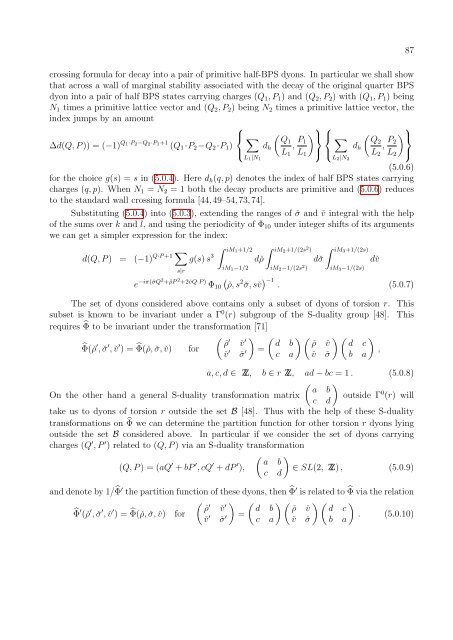PHYS08200604018 Shamik Banerjee - Homi Bhabha National ...
PHYS08200604018 Shamik Banerjee - Homi Bhabha National ...
PHYS08200604018 Shamik Banerjee - Homi Bhabha National ...
Create successful ePaper yourself
Turn your PDF publications into a flip-book with our unique Google optimized e-Paper software.
crossing formula for decay into a pair of primitive half-BPS dyons. In particular we shall show<br />
that across a wall of marginal stability associated with the decay of the original quarter BPS<br />
dyon into a pair of half BPS states carrying charges (Q 1 , P 1 ) and (Q 2 , P 2 ) with (Q 1 , P 1 ) being<br />
N 1 times a primitive lattice vector and (Q 2 , P 2 ) being N 2 times a primitive lattice vector, the<br />
index jumps by an amount<br />
⎧<br />
⎨ ∑<br />
(<br />
∆d(Q, P )) = (−1) Q 1·P 2 −Q 2·P 1 +1 Q1<br />
(Q 1·P 2 −Q 2·P 1 ) d h , P ) ⎫ ⎧<br />
⎬ ⎨ ∑<br />
1<br />
⎩ L 1 L 1 ⎭ ⎩<br />
L 1 |N 1<br />
L 2 |N 2<br />
87<br />
(<br />
Q2<br />
d h , P ) ⎫ ⎬<br />
2<br />
L 2 L 2 ⎭<br />
(5.0.6)<br />
for the choice g(s) = s in (5.0.4). Here d h (q, p) denotes the index of half BPS states carrying<br />
charges (q, p). When N 1 = N 2 = 1 both the decay products are primitive and (5.0.6) reduces<br />
to the standard wall crossing formula [44, 49–54, 73, 74].<br />
Substituting (5.0.4) into (5.0.3), extending the ranges of ˇσ and ˇv integral with the help<br />
of the sums over k and l, and using the periodicity of Φ 10 under integer shifts of its arguments<br />
we can get a simpler expression for the index:<br />
d(Q, P ) = (−1) Q·P +1 ∑ s|r<br />
∫ iM1 +1/2<br />
g(s) s 3 dˇρ<br />
iM 1 −1/2<br />
∫ iM2 +1/(2s 2 )<br />
iM 2 −1/(2s 2 )<br />
dˇσ<br />
∫ iM3 +1/(2s)<br />
iM 3 −1/(2s)<br />
e −iπ(ˇσQ2 +ˇρP 2 +2ˇvQ·P ) Φ 10<br />
(ˇρ, s2ˇσ, sˇv ) −1<br />
. (5.0.7)<br />
The set of dyons considered above contains only a subset of dyons of torsion r. This<br />
subset is known to be invariant under a Γ 0 (r) subgroup of the S-duality group [48]. This<br />
requires ̂Φ to be invariant under the transformation [71]<br />
( ) ( ) ( ) ( )<br />
̂Φ(ˇρ ′ , ˇσ ′ , ˇv ′ ) = ̂Φ(ˇρ, ˇρ<br />
′<br />
ˇv<br />
ˇσ, ˇv) for<br />
′ d b ˇρ ˇv d c<br />
ˇv ′ ˇσ ′ =<br />
,<br />
c a ˇv ˇσ b a<br />
a, c, d ∈ Z, b ∈ r Z, ad − bc = 1 . (5.0.8)<br />
( )<br />
a b<br />
On the other hand a general S-duality transformation matrix outside Γ<br />
c d<br />
0 (r) will<br />
take us to dyons of torsion r outside the set B [48]. Thus with the help of these S-duality<br />
transformations on ̂Φ we can determine the partition function for other torsion r dyons lying<br />
outside the set B considered above. In particular if we consider the set of dyons carrying<br />
charges (Q ′ , P ′ ) related to (Q, P ) via an S-duality transformation<br />
( )<br />
a b<br />
(Q, P ) = (aQ ′ + bP ′ , cQ ′ + dP ′ ),<br />
∈ SL(2, Z) , (5.0.9)<br />
c d<br />
and denote by 1/̂Φ ′ the partition function of these dyons, then ̂Φ ′ is related to ̂Φ via the relation<br />
( ) ( ) ( ) ( )<br />
̂Φ ′ (ˇρ ′ , ˇσ ′ , ˇv ′ ) = ̂Φ(ˇρ, ˇρ<br />
′<br />
ˇv<br />
ˇσ, ˇv) for<br />
′ d b ˇρ ˇv d c<br />
ˇv ′ ˇσ ′ =<br />
. (5.0.10)<br />
c a ˇv ˇσ b a<br />
dˇv

















